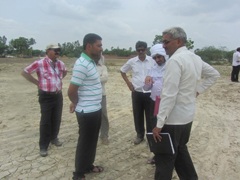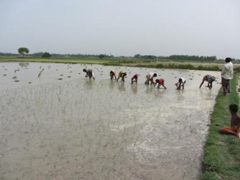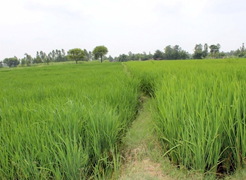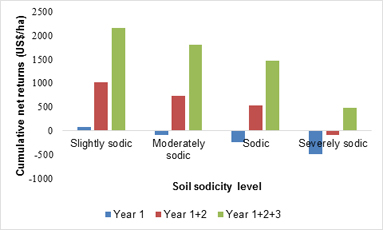Land degradation due to the accumulation of salts in the soil is an alarming threat to agricultural productivity and sustainability, particularly in arid and semiarid regions of the world. In India, about 6.73 million ha soils are salt affected which represents 2.1% of the geographical area of the country. Out of these, 2.8 million ha are sodic and mainly occur in the alluvial soils of the Indo-Gangetic plains (IGP) and a large proportion of these soils are cultivated by smallholder farmers, who rely on that piece of land to satisfy their food and feed needs.



Santaraha village in Hardoi district of Uttar Pradesh extending from N 270 36’ 31” to 270 36’ 32” latitude and E 800 11’ 34” to 800 11’ 52” longitude at an elevation of 139 m above mean sea level was selected for farmer’s participatory sodic soil reclamation programme by ICAR-Central Soil Salinity Research Institute, Karnal. The average size of land holding was 0.62 ha and the majority of the farmers belong to marginal category Crop production was an important activity contributing 68% of the total household income in the area.
The farmers were apprised about the role and responsibilities to be shared by them. After collecting all the basic information, the reclamation process started April 2011. Proper reclamation protocol was followed. On-farm development works like bunding, field drains, irrigation channels, levelling and construction of link drain were initiated in farmers participatory mode. Land owners were asked to collect soil samples from each plot after training by the CSSRI, Scientists and Staff. To ensure water availability for leaching of salts as well as irrigating crops, one tube well was established at each 4.0 ha land stretch. The soil analysis results revealed that the pH ranges 8.5 to 10.1 and the gypsum requirement (GR) from 8.2 to 14.8 Mg ha-1. Based on the results of laboratory analysis, gypsum was provided to the farmers @ 25% of estimated GR value. Agriculture grade mineral gypsum containing S (16.1%), Ca (18.3%), Mg (0.04%), and Na (0.18%) was applied in June 2012 and mixed uniformly in the top soil (0-15cm).
After application and mixing of gypsum, fields were ponded about 10 cm water for at least 10 days to displace the reaction product of Ca-Na exchange down to the root zone. After proper leaching of salts, pressmud collected from sugar company containing S (0.23%), Ca (11%), Mg (1.65%), total C (26%), total N (1.33%), total P (1.08%) and total K (0.53%) was broadcast uniformly @ 10 t ha-1 and mixed in to the top soil. During this reclamation process farmers share substantial amount of cost. All the initial pre-reclamation activities were managed by the farmers on their own cost. They also shared the cost of amendments and inputs. Seed of salt tolerant variety of rice ‘CSR 36’ was provided by the ICAR-Central Soil Salinity Research Institute (CSSRI), Regional Research Station, Lucknow. Thirty-day-old seedlings of the salt tolerant rice variety ‘CSR 36’ was transplanted in July and improved management practices developed for sodic soils were followed.
After three years of reclamation all uncultivated lands reported before initiating the reclamation have been put under cultivation. The rice yield declined in slightly sodic and moderately sodic soils indicating 39.43 and 74.95%, respectively. However, yield reduction in sodic and severely sodic soil was 100% because there was no crop at this sodicity level. After reclamation, the yield loss over the normal soil reduced drastically. Wheat yield loss during pre reclamation in slightly sodic and moderately sodic soils were 22.74 and 61.09%, respectively whereas, at sodic and severely sodic soils there was no crop. After post reclamation, yield loss at slightly sodic, moderately sodic, sodic and severely sodic soils reduced to the levels of 10.87, 21.84, 34.21 and 50.92% over the normal soils.
Average yield (t ha-1) of rice and wheat pre and post reclamation in the selected area
| Year |
Soil Sodicity class |
||||
|
Normal |
Slightly sodic |
Moderately sodic |
Sodic |
Severely sodic |
|
|
Rice |
|||||
|
Pre-reclamation period |
|||||
|
2009-2010 |
4.81 |
2.92 |
1.21 |
0 |
0 |
|
2010-2011 |
4.94 |
2.98 |
1.25 |
0 |
0 |
|
2011-2012 |
4.86 |
2.95 |
1.20 |
0 |
0 |
|
Average |
4.87 |
2.95 |
1.22 |
0 |
0 |
|
% yield loss |
- |
39.43 |
74.95 |
100 |
100 |
|
Post reclamation period |
|||||
|
2011-2012 |
5.10 |
4.83 |
4.38 |
3.87 |
2.79 |
|
2012-2013 |
5.23 |
5.12 |
4.73 |
4.54 |
3.10 |
|
2013-2014 |
5.32 |
5.04 |
4.86 |
4.86 |
3.23 |
|
Average |
5.21 |
4.99 |
4.65 |
4.42 |
3.04 |
|
Yield loss (%) |
|
4.35 |
10.74 |
15.16 |
41.65 |
|
Wheat |
|||||
|
Pre-reclamation period |
|||||
|
2009-2010 |
3.57 |
2.76 |
1.23 |
0 |
0 |
|
2010-2011 |
3.70 |
2.85 |
1.41 |
0 |
0 |
|
2011-2012 |
3.67 |
2.84 |
1.62 |
0 |
0 |
|
Average |
3.65 |
2.82 |
1.42 |
0 |
0 |
|
% yield loss |
- |
22.74 |
61.09 |
100 |
100 |
|
Post reclamation period |
|||||
|
2011-2012 |
3.67 |
3.13 |
2.76 |
2.10 |
1.63 |
|
2012-2013 |
3.81 |
3.43 |
3.02 |
2.63 |
1.82 |
|
2013-2014 |
3.84 |
3.53 |
3.12 |
2.72 |
2.10 |
|
Average |
3.77 |
3.36 |
2.96 |
2.48 |
1.85 |
|
Yield loss (%) |
- |
10.87 |
21.48 |
34.21 |
50.92 |
During first year of reclamation positive net returns were observed only for slightly sodic soils. With increasing levels of soil sodicity, the net return in the first year became increasingly negative. In 2012-13, net returns increased remarkably, because the high reclamation expenditures occurred only in 2011-12. A further increase in net returns occurred in 2013-14

Cumulative net returns from rice farming over a three year period of reclamation
This shows that the crop yield gap and income loss were substantially reduced after reclamation due to reduction in the soil sodicity level and land became suitable for crop production. Several efforts have been made by the government agencies to reclaim salt affected soils and bring them under productive use but still, a large part of agricultural land is abandoned in India due to severe sodicity related problems. These lands need to be reclaimed through farmer’s participatory approach following integration of gypsum, pressmud and salt tolerant varieties a cost effective technology for a faster and sustainable reclamation and to improve land productivity and farm income of resource poor farmers. The technology has the potential to reduce the reclamation cost remarkably, making it easier for resource poor farmer to adopt the practice. This would save the amount of chemical amendments needed that can further contribute to reclaim an even larger area. It is also concluded that the participatory reclamation and management approach is highly relevant and effective to ensure sustainable reclamation of sodic soils.
(Source: ICAR-Central Soil Salinity Research Institute, Karnal)








Like on Facebook
Subscribe on Youtube
Follow on X X
Like on instagram